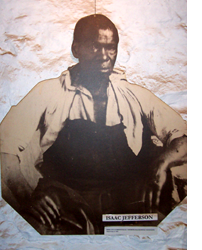 Yesterday’s trip to Thomas Jefferson’s Monticello was a very fruitful day. This was my first time back since August of 2007 and there have been some wonderful additions to the site in my absence. Before I begin with what I hope will be a very original and insightful post, I do have to share three, very important revelations:
Yesterday’s trip to Thomas Jefferson’s Monticello was a very fruitful day. This was my first time back since August of 2007 and there have been some wonderful additions to the site in my absence. Before I begin with what I hope will be a very original and insightful post, I do have to share three, very important revelations:
1. Uploading video from your Blackberry while standing on top of a mountain is an exercise in futility.
2. IF you take a photo in the new exhibit hall using a flash, you will set off an alarm (trust me).
3. The new Visitor’s Center is excellent, although I believe there are far less artifacts on display.
Thursday’s expedition had a very important goal, to specifically examine how slavery is now being interpreted and presented at the new Monticello. In one of my essays written for The Jefferson Project, I recalled how I typically glanced over the issue of racism when visiting Jefferson’s home. Today, my eyes have been opened to examining these uncomfortable issues and acknowledging the hypocrisy that existed in the practices of the Founding Fathers. Please note that my respect for this man has not changed, Jefferson was both brilliant and inspiring. The difference is that I now remain in awe of a man who was quite imperfect, just like the rest of us.
My revelation came as I began to take a more critical look at the life and legacy of Thomas Jefferson. Recently I posted here and here on my reading of Gary Wills’ book “Negro President” Jefferson and the Slave Power, as well as The Hemingses of Monticello: An American Family by Annette Gordon-Reed. Admittedly, I had no idea how influential the institution of human bondage was to the establishment and operation of our nation’s earliest federal government. For example, the “three-fifths [slave] clause” of the Constitution tremendously benefited men like Thomas Jefferson and enabled slaveholders to retain high-level political positions for generations.
It was with this newfound perspective that I set out to revisit Jefferson's home. I am aware of some fellow CW bloggers who are re-examining race and memory in regards to the Civil War, but I believe I am the first to take this approach with the newly updated Monticello. My post today looks at four major parts of the visitor’s experience: the visitor’s center and gallery, the house tour, Mulberry Row, and the new guidebook. I took extra special care to record via photo, video, and notes, how slavery was interpreted and presented at each of these venues. (Unfortunately, the video aspect was not successful as I do not believe silent camera pans of displays are worth your time. Therefore I am sticking with the photos and my own observations.)
The objective of this post is to inspire you to visit Monticello just as I did, with a fresh curiosity and newfound perspective. (All photographs were taken on site.)
1. Visitor's Center
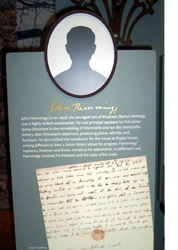 First up is the new Monticello Visitors Center and Smith Education Center. There are two main galleries at this location (along with a theater, café, gift shop, and research library). Both exhibit halls feature specific displays dealing with slavery and the labor force at Monticello. Both sections appear dedicated to recognizing the contributions of the slave community. In the upstairs gallery there is a biography card on Issac Jefferson who had served as a blacksmith, tinsmith, and nailer. You may remember that Issac’s memoirs were recorded by an interviewer and remain among the most insightful narratives about the day-to-day lives of Monticello’s inhabitants. Isaac held a sincere affection for his owner and was reported as saying, “Old Master was very kind to servants.” (For additional quotes see Jefferson at Monticello, Recollections of a Monticello Slave and a Monticello Overseer. Edited by James Adam Bear, Jr.).
First up is the new Monticello Visitors Center and Smith Education Center. There are two main galleries at this location (along with a theater, café, gift shop, and research library). Both exhibit halls feature specific displays dealing with slavery and the labor force at Monticello. Both sections appear dedicated to recognizing the contributions of the slave community. In the upstairs gallery there is a biography card on Issac Jefferson who had served as a blacksmith, tinsmith, and nailer. You may remember that Issac’s memoirs were recorded by an interviewer and remain among the most insightful narratives about the day-to-day lives of Monticello’s inhabitants. Isaac held a sincere affection for his owner and was reported as saying, “Old Master was very kind to servants.” (For additional quotes see Jefferson at Monticello, Recollections of a Monticello Slave and a Monticello Overseer. Edited by James Adam Bear, Jr.).
Next to Issac’s display are matching bios of John Hemings, a tremendously skilled woodworker who crafted much of the interior woodwork of Jefferson’s house at Poplar Forest, as well the most famous of all Monticello’s slaves, Sally Hemings. Of course her relationship with Thomas Jefferson has been the subject of great controversy. According to the Thomas Jefferson Foundation’s official statement on the matter: “Although the relationship between Jefferson and Sally Hemings has been for many years, and will surely continue to be, a subject of intense interest to historians and the public, the evidence is not definitive, and the complete story may never be known. The Foundation encourages its visitors and patrons, based on what evidence does exist, to make up their own minds as to the true nature of the relationship.”
This stance continues today in various publications on the matter including the visitor’s handbook (more on that later). In addition to these bio cards, artifacts including some of the slave’s handiwork are on display. The craftsmanship that these men achieved, made even more impressively with the lack of technology, is beyond remarkable. Slave labor at Monticello was definitely skilled labor.
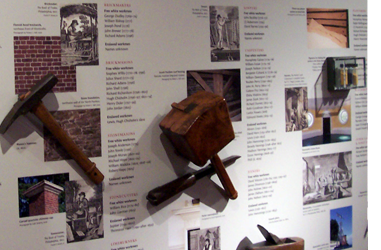 In the downstairs gallery, a large display titled “Those Who Built Monticello” presents the tradesmen, free and enslaved, as well as the tools they used to construct Jefferson’s magnificent estate. According to the plaque, “Jefferson required highly-skilled workmen to realize his vision for Monticello. In Philadelphia in 1798 he engaged James Dinsmore, an Irish house joiner, to take charge of the ongoing construction in his absences. Dinsmore worked closely with enslaved joiner John Hemings to create much of Monticello’s fine woodwork. The team of joiners also included James Oldham (1801-04) and John Neilson (1805-09), and another enslaved man, Lewis...”
In the downstairs gallery, a large display titled “Those Who Built Monticello” presents the tradesmen, free and enslaved, as well as the tools they used to construct Jefferson’s magnificent estate. According to the plaque, “Jefferson required highly-skilled workmen to realize his vision for Monticello. In Philadelphia in 1798 he engaged James Dinsmore, an Irish house joiner, to take charge of the ongoing construction in his absences. Dinsmore worked closely with enslaved joiner John Hemings to create much of Monticello’s fine woodwork. The team of joiners also included James Oldham (1801-04) and John Neilson (1805-09), and another enslaved man, Lewis...”
It continued, “John Hemings, the son of Elizabeth (Betty) Hemings, apprenticed under Dinsmore and hired joiners. He became an accomplished craftsman, succeeded Dinsmore as head joiner in 1809, and trained other slaves in his trade, including his nephews Madison and Eston Hemings. A Monticello overseer recalled that Hemings ‘could make anything that was wanted in woodwork.’ He made fine furniture, a landau carriage, and much of the interior woodwork at Poplar Forest. Jefferson freed Hemings in his will and gave him all the tools of his shop. Continuing to work for the Jefferson family, Hemings lived for several more years at Monticello with his wife, Priscilla.”
2. House and Dependencies Tour
Second in my investigation, the traditional house tour and dependency exhibits. Nothing major has changed noticeably at the top of the hill, although the guided tours are now more open to discussing the institution of slavery and how it was a crucial element in the construction, maintenance and operation of Monticello. Our guide immediately made a point of presenting Jefferson as a typical Virginia plantation owner who had established his lifestyle on the benefits of slave labor. She quoted Jefferson as saying that he abhorred slavery, and believed that he looked at his slaves with a paternalistic view, that they were children who required his supervision. She then countered that notion by saying that dozens of Monticello’s 200 slaves had been traded off by Jefferson and that if one judged him by his deeds and not his words, slavery was something that benefited him greatly. Other than the usual mention of the house staff's chores and showing the dumbwaiters and kitchen carousel, the rest of the tour steered clear of the topic.
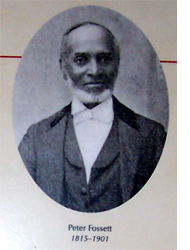 Underneath the house, there were several displays in the center alcove presenting the servant’s quarters, found artifacts, and slave life including that of Issac Jefferson. The kitchen areas in particular presented how Jefferson had his slave cooks trained by French chefs in the traditional dish preparations of the time. Adjacent quarters presented the life of a slave named Joseph Fossett. The plaque reads, “Joseph Fossett (1780-1858) was the grandson of Elizabeth (Betty Hemings) and the son of Mary Hemings Bell, who became free in the 1790s while her son remained a slave at Monticello. According to overseer Edmund Backon, Fossett, a blacksmith, was ‘a very fine workman; could do anything it was necessary to do with steel or iron.’ Joseph and Edith Fossett had ten children, from James, born in the President’s House in 1805, to Jesse, born in 1830. Although Joseph Fossett was freed in Jefferson’s will, his wife and children were sold at the Monticello estate auction in 1827. He continued to work as a blacksmith and, with the help of his mother and other free family members, was able to purchase the freedom of Edith and some of their children. They moved to Cincinnati, Ohio, in the 1840s. In 1850 their son Peter, who left a number of recollections of his life, became free and joined his family in Cincinnati, where he was a prominent caterer and Baptist minister.”
Underneath the house, there were several displays in the center alcove presenting the servant’s quarters, found artifacts, and slave life including that of Issac Jefferson. The kitchen areas in particular presented how Jefferson had his slave cooks trained by French chefs in the traditional dish preparations of the time. Adjacent quarters presented the life of a slave named Joseph Fossett. The plaque reads, “Joseph Fossett (1780-1858) was the grandson of Elizabeth (Betty Hemings) and the son of Mary Hemings Bell, who became free in the 1790s while her son remained a slave at Monticello. According to overseer Edmund Backon, Fossett, a blacksmith, was ‘a very fine workman; could do anything it was necessary to do with steel or iron.’ Joseph and Edith Fossett had ten children, from James, born in the President’s House in 1805, to Jesse, born in 1830. Although Joseph Fossett was freed in Jefferson’s will, his wife and children were sold at the Monticello estate auction in 1827. He continued to work as a blacksmith and, with the help of his mother and other free family members, was able to purchase the freedom of Edith and some of their children. They moved to Cincinnati, Ohio, in the 1840s. In 1850 their son Peter, who left a number of recollections of his life, became free and joined his family in Cincinnati, where he was a prominent caterer and Baptist minister.”
3. Mulberry Row
Third and perhaps the most direct display of slave life at Monticello is the stops along Mulberry Row. In addition to traditional placards, brick ruins mark the areas of significance. Named for the mulberry trees planted along it, Mulberry Row was the center of plantation activity at Monticello from the 1770s to Jefferson’s death in 1826. Five log dwellings for slaves were located on Mulberry Row in 1796. The Mulberry Row cabins were occupied mainly by household servants -- women who did the cooking, washing, house cleaning, sewing, and child tending. According to Monticello’s website, “Not all slaves lived on Mulberry Row. A small number who were household servants lived in rooms in the basement-level dependency wings of Monticello, and others lived in cabins located elsewhere at Monticello and outlying farms.”
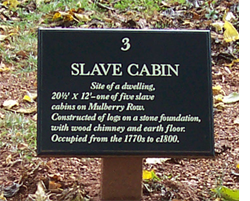 Stops along the way include slave dwellings, workman’s house, storehouse, blacksmith shop, nailery and a joinery. Some people may not be aware that all building materials including Monticello’s bricks and nails were made on site. I was surprised to learn that white workers also lived along this section of the estate. The T.J. Foundation states that, “A blacksmith shop was built on this site about 1793. Here Jefferson’s slaves Little George, Moses, and Joe Fossett shoed horses, repaired the metal parts of plows and hoes, replaced gun parts, and made the iron portions of the carriages that Jefferson designed. Neighboring farmers brought work to the shop as well, and the slave blacksmiths were given a percentage of the profits of their labor. In 1794, Jefferson added a nailmaking operation to the shop, in an effort to provide an additional source of income. Nailrod was shipped to Monticello by water from Philadelphia and was hammered into nails by as many as fourteen young male slaves, aged ten to sixteen.”
Stops along the way include slave dwellings, workman’s house, storehouse, blacksmith shop, nailery and a joinery. Some people may not be aware that all building materials including Monticello’s bricks and nails were made on site. I was surprised to learn that white workers also lived along this section of the estate. The T.J. Foundation states that, “A blacksmith shop was built on this site about 1793. Here Jefferson’s slaves Little George, Moses, and Joe Fossett shoed horses, repaired the metal parts of plows and hoes, replaced gun parts, and made the iron portions of the carriages that Jefferson designed. Neighboring farmers brought work to the shop as well, and the slave blacksmiths were given a percentage of the profits of their labor. In 1794, Jefferson added a nailmaking operation to the shop, in an effort to provide an additional source of income. Nailrod was shipped to Monticello by water from Philadelphia and was hammered into nails by as many as fourteen young male slaves, aged ten to sixteen.”
The crumbled foundation remains of a typical Mulberry Row slave cabin. According to the plaque, the structures were approximately 20 ft. x 12 ft., constructed of logs on a stone foundation, with a wood chimney and earth floor. These buildings overlooked the main produce gardens. Today there is a special Plantation Tour available that covers the slave community and its daily contribution in more detail. Mulberry Row is a main focal point of the walking tour.

(Excerpt: In 1796 there were 110 African-Americans living on the 5,000-acre plantation, almost half of them children.)
4. Monticello Visitor's Guidebook
Fourth and finally, my attentions were drawn to the newly updated Monticello Visitor’s Guide. I always save my brochures, maps and handouts when touring historical sites and was able to refer back to the old version. I also had a children’s handout from 2007 which I have always been curious about. The illustrations that explain to children the day-to-day life at Monticello depict slaves happily cooking in the kitchen and playing with the Jefferson children around the fish pond. No doubt slave-master relationships like this existed, but these representations seemed a little too “happy-go-lucky” for my tastes. Of course little children are far too young to understand or comprehend the issues of slavery, but these candy-coated drawings were over the top.
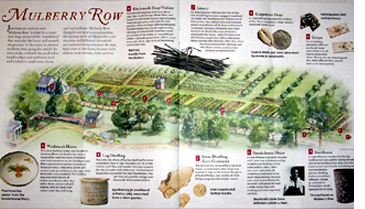 The new Monticello guidebook features two large spreads dealing with slave labor. The first is titled “Mulberry Row” and includes an illustrated map of the grounds and photographs of artifacts. Once again Issac Jefferson makes an appearance (clearly the most exhibited slave on the premises). A section on the Storehouse states, “In 1796 Jefferson recorded that the log building here was used for storing iron and nail rod for the blacksmith shop and nailery. It also served over time for tinsmithing and nail manufacture and as a dwelling. A slave named Issac Jefferson, trained as a tinsmith in Philadelphia, briefly operated the tin shop.”
The new Monticello guidebook features two large spreads dealing with slave labor. The first is titled “Mulberry Row” and includes an illustrated map of the grounds and photographs of artifacts. Once again Issac Jefferson makes an appearance (clearly the most exhibited slave on the premises). A section on the Storehouse states, “In 1796 Jefferson recorded that the log building here was used for storing iron and nail rod for the blacksmith shop and nailery. It also served over time for tinsmithing and nail manufacture and as a dwelling. A slave named Issac Jefferson, trained as a tinsmith in Philadelphia, briefly operated the tin shop.”
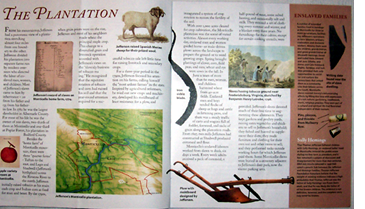 The second spread is titled “The Plantation” and deals specifically with the institution of slavery. It states, “Most of Jefferson’s slaves came to him by inheritance – 20 from his father and 135 from his father-in-law. In 1782, he was the largest slaveholder in Albemarle County. For most of his life he was the owner of 200 slaves, two-thirds of them at Monticello and one-third at Poplar Forest, his plantation in Bedford County.” A photograph of Jefferson’s record of slaves compliments the copy and a sidebar deals directly with the subjects of enslaved families and Sally Hemings. Both of these are new additions and bear quoting here:
The second spread is titled “The Plantation” and deals specifically with the institution of slavery. It states, “Most of Jefferson’s slaves came to him by inheritance – 20 from his father and 135 from his father-in-law. In 1782, he was the largest slaveholder in Albemarle County. For most of his life he was the owner of 200 slaves, two-thirds of them at Monticello and one-third at Poplar Forest, his plantation in Bedford County.” A photograph of Jefferson’s record of slaves compliments the copy and a sidebar deals directly with the subjects of enslaved families and Sally Hemings. Both of these are new additions and bear quoting here: “Enslaved Families: A number of extended families lived in bondage at Monticello for three or more generations, facilitating Jefferson’s operations as farm laborers, artisans, tradesmen and domestic workers. Among them were the children, grandchildren, and great-grandchildren of Elizabeth Hemings, David and Isabel Hern, Edward and Jane Gillette, and James and Cate Hubbard. Nights, Sundays, and holidays provided the only opportunities to socialize and nurture their connections that united them as a community. Like their fellows across the South, Monticello slaves resisted slavery’s dehumanizing effects by filling this time with expressions of a rich culture: gardening, needlework, music, religious practice. They were part of a cultural and spiritual life that flourished independent of their masters.”
“Sally Hemings: That Thomas Jefferson fathered children with Sally Hemings, an enslaved ladies’ maid at Monticello, entered the public arena during his first term as president, and it has remained a subject of discussion and disagreement for more than two centuries. DNA tests results released in 1998 indicated a genetic link between the Jefferson and Hemings families. Thomas Jefferson Foundation historians believe that the weight of existing evidence indicates a high probability that Thomas Jefferson was the father of Sally Hemings’ son Eston (born 1808), and that he was likely the father of all her known children. The evidence is not definitive, however, and the complete story may never be known.” (Our friend Richard Williams recently posted some thoughts on his blog about a book by William G. Hyland Jr. titled In Defense of Thomas Jefferson: The Sally Hemings Sex Scandal, which takes the opposite stance.)
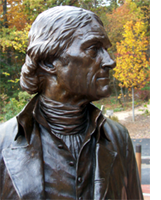 I have to admit that this trip to Monticello yielded a variety of different conclusions for me. The Thomas Jefferson that I recognize today was a man who may very well have held a sincere paternalistic fondness for his slaves, but at the same time, he held them in the chains of bondage. Despite the fact that many of his servants received specialized training and developed trades that resulted in the creation of great things, they were simultaneously denied the basic principle of freedom. This is where the contradiction of the man who penned the Declaration of Independence lies. Thomas Jefferson was an extraordinary man whose contributions to this country cannot be denied, but he was also a man who held racist views of the period. This is an undeniable truth.
I have to admit that this trip to Monticello yielded a variety of different conclusions for me. The Thomas Jefferson that I recognize today was a man who may very well have held a sincere paternalistic fondness for his slaves, but at the same time, he held them in the chains of bondage. Despite the fact that many of his servants received specialized training and developed trades that resulted in the creation of great things, they were simultaneously denied the basic principle of freedom. This is where the contradiction of the man who penned the Declaration of Independence lies. Thomas Jefferson was an extraordinary man whose contributions to this country cannot be denied, but he was also a man who held racist views of the period. This is an undeniable truth.
Thankfully, the folks at Monticello are not shying away from this aspect of Jefferson’s life and the Foundation has made great strides to include an African-American presence in their presentation. It not only fills a void of far too neglected history, it also makes Thomas Jefferson human. Try to keep this in mind the next time that you visit Monticello and see if you too leave with a broader understanding of this remarkable, yet flawed Founding Father.
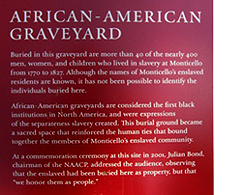 UPDATE: One additional area that fits the attention of this study is the African-American graveyard that is located on the grounds of the estate. According to the sign, this cemetery is the final resting place of 40+ blacks who lived in slavery at Monticello from 1770-1827. It adds that although the names of Jefferson's slaves were known, it has not been possible to identify any of those buried here. This is perhaps one of the most telling of all the exhibits as a separate burial plot personified the society of segregation that even in death, existed at Thomas Jefferson's Monticello.
UPDATE: One additional area that fits the attention of this study is the African-American graveyard that is located on the grounds of the estate. According to the sign, this cemetery is the final resting place of 40+ blacks who lived in slavery at Monticello from 1770-1827. It adds that although the names of Jefferson's slaves were known, it has not been possible to identify any of those buried here. This is perhaps one of the most telling of all the exhibits as a separate burial plot personified the society of segregation that even in death, existed at Thomas Jefferson's Monticello.
Updated: Monday, 2 November 2009 1:34 PM EST
Permalink | Share This Post
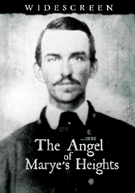
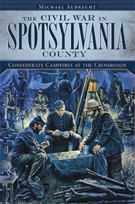
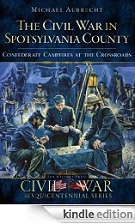

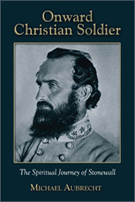

 On Thursday I will be posting text, photos and videos from Thomas Jefferson’s Monticello. This will be my first visit in two years and as I am looking at ways of utilizing the emerging mobile technology available via Blackberry, I can’t think of a better place to experiment with mobile blogging.
On Thursday I will be posting text, photos and videos from Thomas Jefferson’s Monticello. This will be my first visit in two years and as I am looking at ways of utilizing the emerging mobile technology available via Blackberry, I can’t think of a better place to experiment with mobile blogging.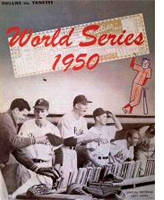 Since you brought it up my friend...
Since you brought it up my friend...  I’ve waited to post anything on the ALCS in fear of jinxing the outcome, but as I sit here watching Mariano Rivera close out Game 6 with a score of NYY 5 - LAA 2, I can safely acknowledge that the 2009 Bronx Bombers have secured the victory and a ticket to the Fall Classic. Well done gentlemen. Well done!
I’ve waited to post anything on the ALCS in fear of jinxing the outcome, but as I sit here watching Mariano Rivera close out Game 6 with a score of NYY 5 - LAA 2, I can safely acknowledge that the 2009 Bronx Bombers have secured the victory and a ticket to the Fall Classic. Well done gentlemen. Well done! 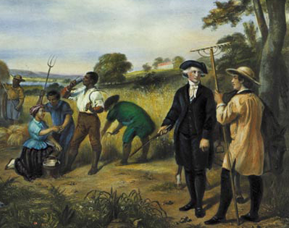 Earlier this month, I
Earlier this month, I